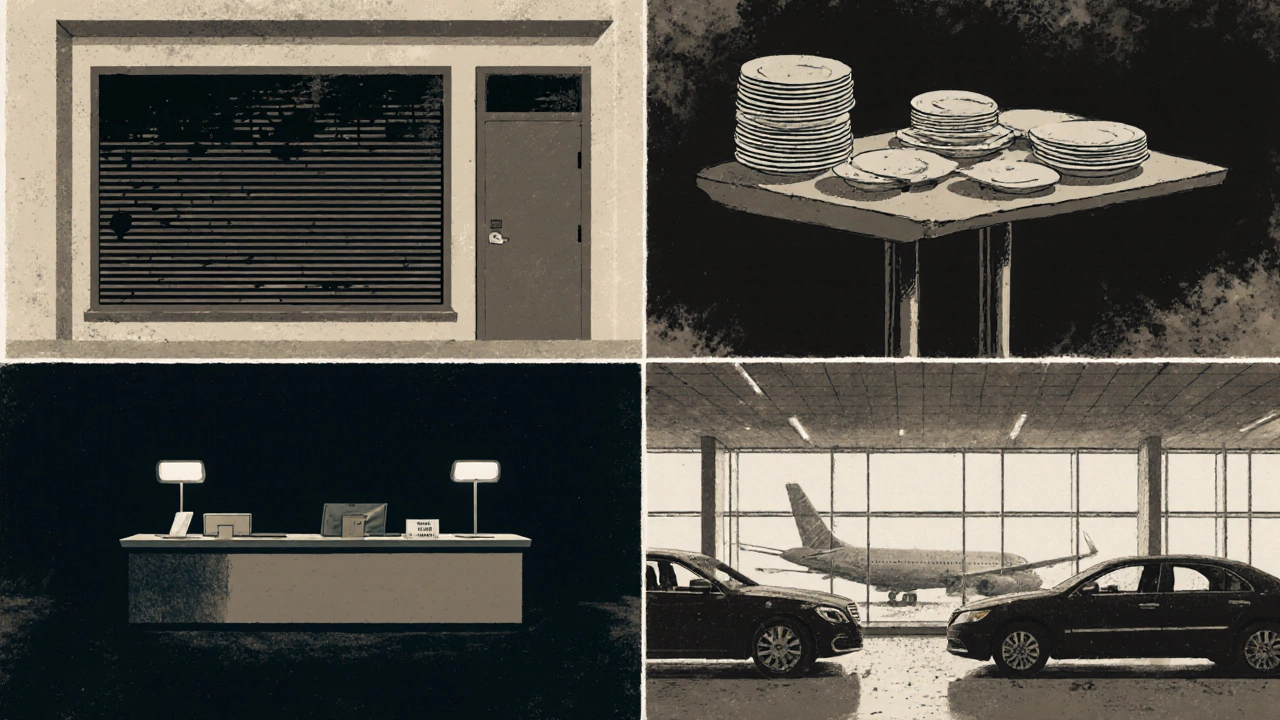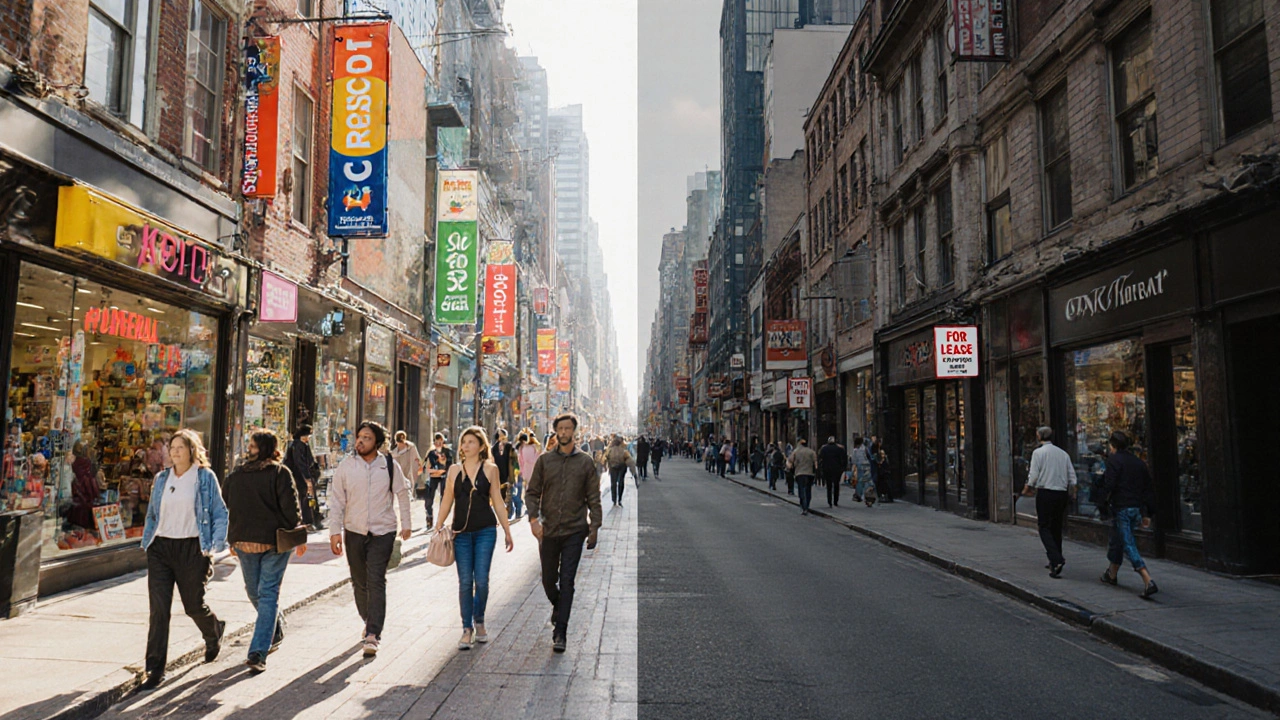Commercial Property Resilience Calculator
How resilient is your property during a recession?
Calculate your commercial property's resilience based on key factors mentioned in the article. Input your property details below to see how vulnerable it might be during economic downturns.
When a recession tightens the economy, not all businesses feel the squeeze equally. Some sectors see sales tumble overnight, while others manage to stay afloat or even grow. Understanding which industries are most vulnerable helps commercial property owners, investors, and sellers make smarter decisions about where to focus their efforts.
What a recession really means for businesses
A recession is a period of sustained economic decline, typically marked by two consecutive quarters of negative GDP growth. During this phase, consumer confidence drops, credit becomes tighter, and spending contracts across the board. Companies that rely heavily on discretionary spending or that carry high fixed costs are usually the first to feel the pain.
Key traits of the hardest‑hit businesses
- High exposure to consumer discretionary income
- Heavy dependence on foot traffic or travel
- Large capital‑intensive operations with thin profit margins
- Limited ability to shift to online or remote models quickly
These traits act like a perfect storm when the economy pulls back.
Sector‑by‑sector breakdown
Below is a snapshot of the most affected industries, why they suffer, and what that means for the commercial properties they occupy.
| Sector | Impact Score | Primary Drivers of Vulnerability | Typical Commercial Property Type |
|---|---|---|---|
| Retail (non‑essential) | 5 | Discretionary spending drop, reduced foot traffic | High‑street storefronts, mall space |
| Hospitality & Food Service | 5 | Travel cuts, lower dining out frequency | Restaurants, hotels, cafés |
| Travel & Tourism | 5 | Business travel freeze, leisure budget cuts | Airports, travel agencies, tour operators |
| Automotive Sales & Dealerships | 4 | Large ticket items, financing tightening | Showrooms, service bays |
| Construction & Real Estate Development | 4 | Credit crunch, project postponements | Office parks, mixed‑use developments |
| Manufacturing (consumer‑goods) | 4 | Reduced orders, inventory overhang | Industrial warehouses, factory floors |
| Professional Services (legal, consulting) | 3 | Clients cut back on advisory spend | Office suites, co‑working spaces |
| Small & Medium Enterprises (SMEs) across sectors | 3 | Cash‑flow strain, limited access to credit | Flexible lease spaces, shared offices |

Why commercial property owners should care
Each sector’s health directly influences the occupancy rates, rental yields, and resale values of the properties they inhabit. For example, a high‑street retail space anchored by a flagship clothing brand may see rent plunges of 20‑30% when consumer spending contracts. Conversely, a warehouse leased to a logistics firm that thrives on e‑commerce growth can remain stable or even rise in demand.
Knowing the risk profile lets you:
- Adjust lease terms-shorter commitments for volatile tenants, longer for resilient ones.
- Prioritize tenant mixes that balance high‑risk and low‑risk businesses.
- Plan proactive marketing to attract recession‑proof tenants (e.g., medical clinics, grocery stores).
- Set realistic pricing expectations when it’s time to sell a property.
Case study: London’s West End retail during the 2020‑2023 downturn
During the post‑Brexit, COVID‑induced slowdown, many luxury brands reduced their square footage or left entirely. Vacancy rates rose from 3% to 12% and average rents fell 18%. However, pharmacies and convenience stores-considered essential-maintained occupancy and even negotiated rent‑free periods to stay open.
This shift reshaped the West End’s tenant mix, turning a purely luxury retail corridor into a hybrid of essential services and experience‑focused venues. For sellers, properties that could accommodate both retail and service uses fetched higher bids than those locked into single‑use leases.
How to evaluate a property’s recession resilience
Use a quick checklist before buying or selling:
- Tenant diversification: Does the building host multiple sectors?
- Lease structures: Are there break‑clause protections for landlords?
- Essential‑service presence: Any grocery, pharmacy, or health‑care tenants?
- Foot‑traffic data: Proximity to transport hubs or residential catch‑areas?
- Adaptability: Can the space be repurposed (e.g., retail to warehouse)?
Properties that score well on these items tend to retain value better when the economy contracts.

Pro tips for sellers during a downturn
- Highlight recession‑proof tenants. Feature any essential services or long‑term leases front and center.
- Offer flexible purchase structures. Seller financing or lease‑back options can sweeten deals when buyers are cash‑constrained.
- Invest in quick‑turn‑around upgrades. Simple improvements-new signage, refreshed interiors-can make a property more attractive without large capital outlay.
- Leverage market data. Cite recent vacancy trends and rent‑growth rates for resilient sectors to back up your asking price.
Looking ahead: Will the same sectors stay vulnerable?
Economic cycles evolve. While retail and hospitality have historically been the most exposed, digital transformation is reshaping risk. For instance, e‑commerce growth has cushioned some traditional retail spaces that can pivot to fulfilment centres.
Staying ahead means monitoring two things:
- Consumer sentiment indices (e.g., GfK, Nielsen)
- Credit availability reports from major banks
When sentiment turns negative and credit tightens, the sectors listed in the table above usually feel the impact first.
Quick FAQ
Which business sector is most vulnerable during a recession?
Non‑essential retail typically tops the list because it depends on discretionary spending, which drops quickly when consumers tighten their belts.
How does a recession affect commercial property values?
Values usually dip in line with rental income. If high‑risk tenants leave, vacancy rises and rents fall, pulling down the overall asset price.
Are there any sectors that perform well in a downturn?
Essential services-grocery, pharmacy, healthcare, and certain logistics firms-often see stable or increased demand because people still need those basics.
What lease clauses can protect landlords?
Break‑clauses tied to tenant turnover, rent‑review mechanisms, and rent‑free periods for essential upgrades can all provide a safety net.
How can I make my property more recession‑resilient?
Diversify tenants, ensure at least one essential‑service occupant, and keep the space flexible enough for quick repurposing.
By mapping out which businesses crumble first and which stay steady, you can position your commercial property to survive, and even thrive, during the next economic downturn.

